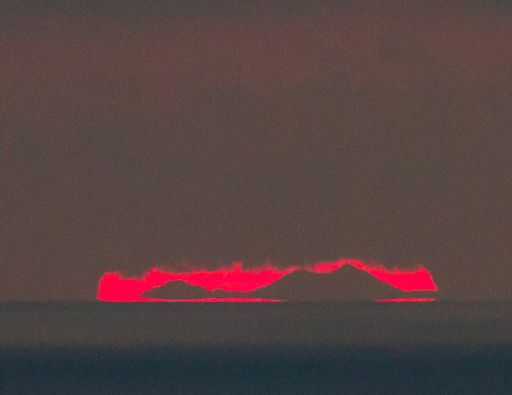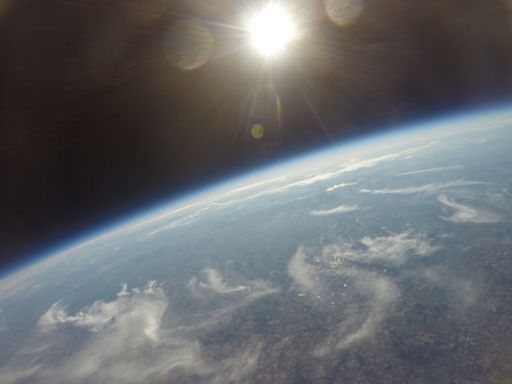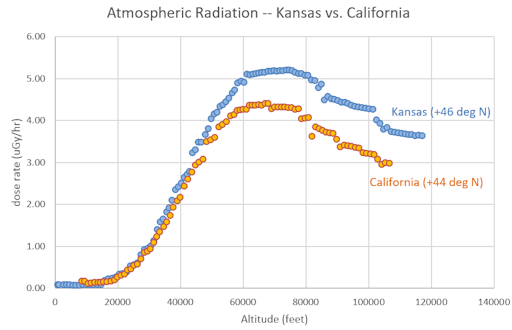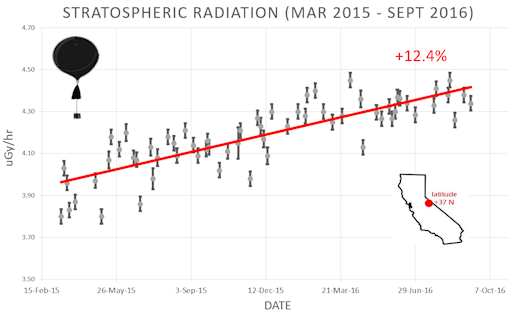Based in Tromsø directly under the Arctic Circle, Marianne's Arctic Xpress offers a comfortable 7 seater minivan for aurora, fjord, whale, and wildlife tours day and night. 100% PASSION and a very high % of finding aurora. Book Now | | | CHANCE OF STORMS, REDUCED: A solar wind stream expected to envelop Earth on Nov. 4th did not arrive. As a result, NOAA forecasters have downgraded the chance of geomagnetic storms today to only 20%. Free: Aurora Alerts THE CANIGOU EFFECT: On the evening of Nov. 1st, J.P. Pettit watched the sunset from Marseille, France. As the fiery solar disk sank into the waters of the Mediterranean Sea, a jagged mountain thrust up in front of the sun. "...which is strange," says Pettit, "because there are no mountains sticking out of the Mediterranean." So he took this picture to document the apparition: 
Indeed, there are no mountains in the Mediterranean, but there are mountains 165 miles away in the Pyrenees. "Pettit witnessed the 'Canigou Effect'," explains atmospheric optic expert Les Cowley. "This is the silhouette of the Pyrenees' Canigou Massif."
"There is no direct line of sight to the Massif because of the Earth's curvature," continues Cowley. "The view is only possible because light is refracted around Earth. Basically, the atmosphere is denser at lower levels and acts like a lens to bend sun rays around the horizon. Mirages can do the same thing, but a mirage was not needed here – just steady and clean air and a long stretch of sea." "What an incredible special effect," says Pettit. "Just WOW!" "This is not a chance observation," adds Cowley. "Alain Origne has made a systematic study of the phenomenon and predicts when it will occur. He would like to hear of other long distance sightings." Realtime Space Weather Photo Gallery SPACE WEATHER BALLOONING OVER KANSAS: Spaceweather.com and the students of Earth to Sky Calculus are continuing to expand the Intercontinental Space Weather Balloon Network. On Oct. 29th, they added a new launch site: Independence, Kansas. Led by a veteran member of Earth to Sky, a team of students and teachers from local schools released their first helium balloon. The payload ascended to the stratosphere, gathering data on temperature, pressure, and cosmic radiation from ground level to 117,000 feet. Here is the view from the apex of the flight: 
Students have been reducing data from the flight, and they have found something surprising. X-ray and gamma radiation in the atmosphere over Kansas is stronger than expected. The plot below compares dose rates vs. altitude for Kansas and our regular launch site in central California: 
Although the two sites are at nearly the same magnetic latitude, their radiation levels are quite different--much more so than we anticipated based on our previous experience flying balloons at different locations in the USA. What's going on here? At the moment, we do not know. However, we plan to fly additional balloons from Kansas to confirm and explore these results. Stay tuned. Realtime Aurora Photo Gallery
Realtime Airglow Photo Gallery
Realtime Sprite Photo Gallery
Every night, a network of NASA all-sky cameras scans the skies above the United States for meteoritic fireballs. Automated software maintained by NASA's Meteoroid Environment Office calculates their orbits, velocity, penetration depth in Earth's atmosphere and many other characteristics. Daily results are presented here on Spaceweather.com. On Nov. 5, 2016, the network reported 29 fireballs.
(21 sporadics, 4 Northern Taurids, 2 Orionids, 1 chi Taurid, 1 November I Draconid)  In this diagram of the inner solar system, all of the fireball orbits intersect at a single point--Earth. The orbits are color-coded by velocity, from slow (red) to fast (blue). [Larger image] [movies] Potentially Hazardous Asteroids ( PHAs) are space rocks larger than approximately 100m that can come closer to Earth than 0.05 AU. None of the known PHAs is on a collision course with our planet, although astronomers are finding new ones all the time. On November 5, 2016 there were potentially hazardous asteroids. Notes: LD means "Lunar Distance." 1 LD = 384,401 km, the distance between Earth and the Moon. 1 LD also equals 0.00256 AU. MAG is the visual magnitude of the asteroid on the date of closest approach. | | Cosmic Rays in the Atmosphere |
Readers, thank you for your patience while we continue to develop this new section of Spaceweather.com. We've been working to streamline our data reduction, allowing us to post results from balloon flights much more rapidly, and we have developed a new data product, shown here: 
This plot displays radiation measurements not only in the stratosphere, but also at aviation altitudes. Dose rates are expessed as multiples of sea level. For instance, we see that boarding a plane that flies at 25,000 feet exposes passengers to dose rates ~10x higher than sea level. At 40,000 feet, the multiplier is closer to 50x. These measurements are made by our usual cosmic ray payload as it passes through aviation altitudes en route to the stratosphere over California. What is this all about? Approximately once a week, Spaceweather.com and the students of Earth to Sky Calculus fly space weather balloons to the stratosphere over California. These balloons are equipped with radiation sensors that detect cosmic rays, a surprisingly "down to Earth" form of space weather. Cosmic rays can seed clouds, trigger lightning, and penetrate commercial airplanes. Furthermore, there are studies ( #1, #2, #3, #4) linking cosmic rays with cardiac arrhythmias and sudden cardiac death in the general population. Our latest measurements show that cosmic rays are intensifying, with an increase of more than 12% since 2015: 
Why are cosmic rays intensifying? The main reason is the sun. Solar storm clouds such as coronal mass ejections (CMEs) sweep aside cosmic rays when they pass by Earth. During Solar Maximum, CMEs are abundant and cosmic rays are held at bay. Now, however, the solar cycle is swinging toward Solar Minimum, allowing cosmic rays to return. Another reason could be the weakening of Earth's magnetic field, which helps protect us from deep-space radiation. The radiation sensors onboard our helium balloons detect X-rays and gamma-rays in the energy range 10 keV to 20 MeV. These energies span the range of medical X-ray machines and airport security scanners. The data points in the graph above correspond to the peak of the Reneger-Pfotzer maximum, which lies about 67,000 feet above central California. When cosmic rays crash into Earth's atmosphere, they produce a spray of secondary particles that is most intense at the entrance to the stratosphere. Physicists Eric Reneger and Georg Pfotzer discovered the maximum using balloons in the 1930s and it is what we are measuring today. | | The official U.S. government space weather bureau | | | The first place to look for information about sundogs, pillars, rainbows and related phenomena. | | | Researchers call it a "Hubble for the sun." SDO is the most advanced solar observatory ever. | | | 3D views of the sun from NASA's Solar and Terrestrial Relations Observatory | | | Realtime and archival images of the Sun from SOHO. | | | from the NOAA Space Environment Center | | | a proud supporter of science education and Spaceweather.com | | | the underlying science of space weather |  | Find homes for sale in Ocala, Orlando and Tampa with the #1 real estate company in Central Florida Local Realty Service |  | Visit Need An Eitzah for all your questions and forum discussions on Jewish life. | | | These links help Spaceweather.com stay online. Thank you to our supporters! | | 
